 Facebook
Facebook
 X
X
 Instagram
Instagram
 TikTok
TikTok
 Youtube
Youtube
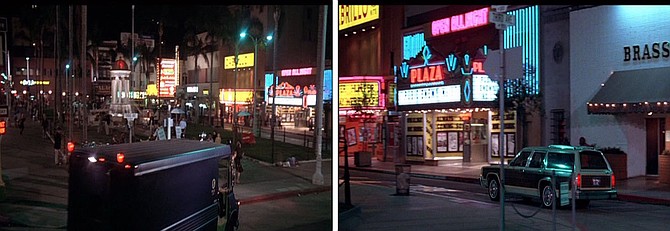
The pre-Gaslamp, premultiplex downtown of 1979 exists today only in the fond memories of cinemaniacs old enough to recall a time when Jaws made you afraid of the water, Friday the 13th made you afraid of hockey masks, and Star Trek: The Motion Picture made you afraid of sequels. Half a dozen eclectic — if mildly disreputable — late-night movie houses operated within a few blocks of each other in the midst of a seedy urban sprawl perfectly suited to the sailors on shore leave and porn aficionados that made up much of its foot traffic. A couple of bucks got you a double or triple bill, screened ’round the clock in cavernous single-screen movie theaters that hearkened back to Hollywood’s golden age, rich in cinematic history and replete with wide aisles and accommodating balconies.
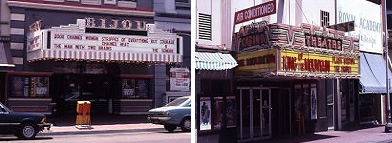
Projectionist Dan Whitehead worked at most of the downtown movie theaters for over 20 years, beginning around Thanksgiving 1972, when he took a projectionist gig with Walnut Properties, who ran both Horton Plaze theaters, the Cabrillo and the Plaza. "We screened The Texas Chainsaw Massacre at the Cabrillo the week it was released in 1973," recalls Whitehead. "The house was packed for all but the earliest and latest showings. It made so much money that the studio jerked it out of our second-run houses and put it in the first-run theaters."
Walnut would take over the Aztec Theater on 5th Avenue, as well as running the Casino Theater down the block and the Bijou across the street, not to mention both the Balboa Theater on 4th, and the nearby Pussycat adult theater. The same duo behind Walnut, Vince Miranda and George Tate, owned the Hotel San Diego and the legit Off Broadway Theater downtown, the latter operating in the old Hollywood Burlesque building.
 (Dan Whitehead high school photo)
(Dan Whitehead high school photo)
"Mr. Miranda was a quiet and energetic guy. We got to know each other during the many drinking parties we had at the main office and at the Hotel San Diego," remembers Whitehead. "He had a motto that he had engraved on his license plate frame -- 'work hard, play hard' -- and that's what we all did. You could tell he really loved show business and loved movies and that it wasn't just a way to make money for him."
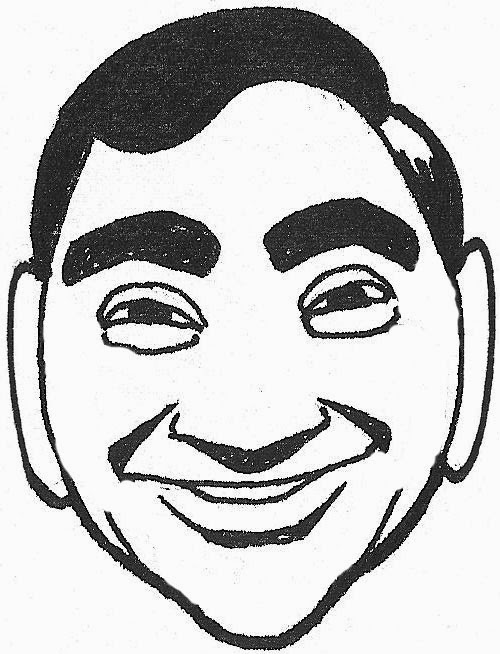 (Miranda by JAS)
(Miranda by JAS)
"Tate used to be a movie extra," says Whitehead. "They supposedly met after getting into a car accident with each other. The story goes that Tate had a theater and Miranda had a restaurant, and they had no money to cover the auto damage, so they just went into business together." Miranda and Tate, who were lovers that shared a home, were both considered the bosses at Walnut, though Tate was seen less by most employees.

Whitehead got to know Tate while training at the Cabrillo. "He had a silver tongue and could probably sell anything to anybody, almost like a snake-oil salesman. He probably could have made millions in religion. My feelings for Mr. Tate soured many years later, when the company was shutting down and Mr. Miranda was dead."
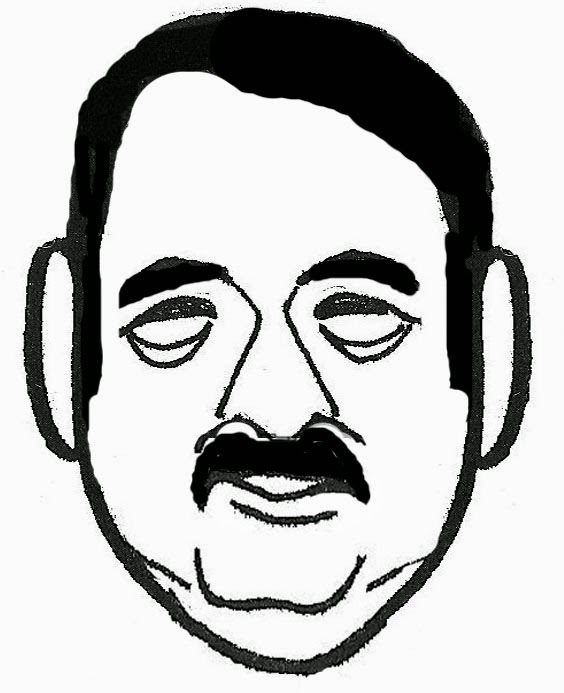 (Tate by JAS)
(Tate by JAS) (Dan Whitehead)
(Dan Whitehead)
Miranda acted as Walnut's public face, frequently mentioned and quoted in the local press by theater critic Welton Jones (a close friend), while Tate was rarely seen or referenced. According to Whitehead, "Tate liked to stay in the shadows. He was always so secretive. There were those of us who wondered if it wasn't really Tate who actually owned the company, and Miranda was just a figurehead. The rumor was that Tate's real name was George Munton and he'd been in some serious trouble having to do with child molestation and couldn't legally own those X-rated houses. That rumor never went away and was told to me by two people who'd known him for many years."
 (Whitehead by JAS)
(Whitehead by JAS)
Miranda and Tate wanted to be downtown's biggest -- if not sole -- grindhouse operators. Walnut purchased a 22-year lease on the Balboa and bought the Casino Theater outright. However, the Russo family who operated the Aztec held on to the Fifth Avenue theater, at least for a while. In 1973, two independent operators -- Charlie Smith and Wesley "Andy" Andrews -- purchased the Aztec property so desired by Walnut. Whitehead ended up quitting his job working for Miranda and Tate to spend a few years as the Aztec's daytime projectionist. "Andy and Charlie's motto on the west reader board of the marquee read 'It's first run 'til you've seen it!' This was actually the brainchild of the night projectionist, Henry 'Hank' Le Clair."
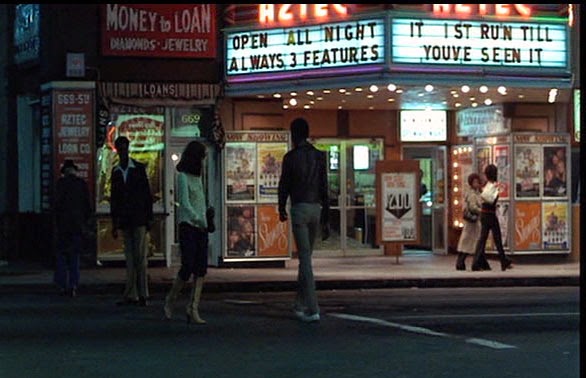
The Aztec was previously run by Russo Family Enterprises (later called El Dorado), until purchased in 1973 by A&S Theater Corporation, owned by Smith and Andrews. The duo had previously run a 16mm X-rated house called the Little Art at the southeast corner of Third and E Street, where they reportedly earned the money to buy and remodel the Aztec. Smith and Andrews reopened the Aztec on January 23, 1974, screening a triple feature that included Paint Your Wagon and The Friends of Eddie Coyle with Robert Mitchum.
"The concession stand had a counter open to the public sidewalk," recalls Whitehead. "Andy and Charlie kept the snack bar stuffed with food and candy, and they even bought a pizza oven and served individual slices of pizza. They had chili for a while, and those wrapped sandwiches you heated in an oven. A lot of downtown hookers and hustlers used the Aztec concession stand as their diner."
The Aztec was known for oddly mismatched double, triple, and even quadruple bills. "There were a few that played there that seemed out of place," says Whitehead, "but then, that was the charm of the place. Andy was a good merchandiser. A couple times, during major holidays, we would run five and six features. On those ocassions, there were not enough house reels and we had to run off the shipping reels, which made the reel end alarm bells inaccurate as the hub of the shipping reels was smaller in diameter than the hubs of the house reels. Good memories."
Walnut and Smith/Andrews - though competing theater operators - eventually warmed toward each other. "Even after I went to work for Andy at the Aztec, I spoke often with Mr. Tate at Walnut," Whitehead says. "I introduced Andy to [George] Tate in 1974, and they became fast friends. Andy leased the Commodore Hotel at Third and F from Tate sometime in the mid-'70s and moved his office there. He was always doing stuff for Walnut. In fact, Andy ran the Hotel San Diego for them for a while." Other downtown inns snapped up by Miranda and Tate included the Clark Hotel and William Penn Hotel on Fifth and the Hotel St. James on Sixth.
Whitehead went back to work for Walnut as the chain's head San Diego projectionist in 1978. "I had a real mess on my hands. The head projectionist had done a lot less than he could have, as far as routine maintenance was concerned." He says the frequent post-shift "drinking parties" with Miranda resumed ("He really liked to drink").
Walnut finally managed to buy the Aztec Theatre, running it as a sister operation to the nearby Casino. The Casino, in the middle of the block and across from the Savoy Theatre (later Walnut's Bijou), was around a half-century old at the time. It was in decent repair, with a full-length balcony that was actually open most of the time. "They ran a little restaurant built onto [the theater] called Loren's Q," remembers Whitehead, "and they had some delicious barbecue. They also served these teeny, tiny little hamburgers they called Q-burgers."
The Aztec also hosted occassional "World Premier" screenings, according to Whitehead. "The debut showings of two so-called 'Blaxploitation' features, Uncle Tom's Cabin (1976) and Dolemite (1975), were I think we billed as 'sneak previews,'" he recalls. "At the time, they were 'exclusives' showing only at the Aztec. I can't remember anything about how it happened that they screened for the first time anywhere at the Aztec and neither can Charlie Smith - I just got off the phone with him. It's most unfortunate that anyone who would remember, apart from Charlie and myself, are all passed away now. Dolemite is in my Netflix queue, but Uncle Tom's Cabin will most likely never, ever be found or even available. It was a terrible movie."
As for those and other "urban" features that tended to attract a racially mixed crowd, Whitehead says San Diego's Walnut houses were surprisingly trouble-free, at least compared to theaters in the chain closer to LA. "I don't recall there ever being any kind of racial issues of any kind, regardless of what kind of movies were playing. There may have been some words-push-shove incidents, but I honestly can't remember even any of those. I'm really glad you mentioned this 'cause I think perhaps we may have been a little bit ahead of the times. I remember when that movie Colors was released. The cops were prepared for all kinds of trouble, and I don't think there was any even then. All in all, it seemed that everyone really did 'get along' as it were."

Over at the Balboa on Fourth Avenue, Walnut used the grand olde girl to screen the same exploitative fare as its other grindhouses, marking what is to some an ignoble period for the one-time crown jewel of downtown theaters. "I was always fascinated by the Balboa and was determined to do my best by her," says Whitehead. "The first thing I did was go over every inch of her, from the roof to the basement."
Among the Balboa's most distinctive features were the waterfalls on either side of the room. "They were in enclosed chambers," says Whitehead. "The one on the left had a little entrance door you got to from the hotel, while the one on the right had no entrance unless you went and got a ladder. The switch that turned them off and on was in the projection booth. I hooked it up to the automation system so they'd turn on when the curtain closed and turn off as soon as the show started. The chambers filled automatically with a ballc-ck assembly filling up the pool at the bottom, just like in a toilet tank. A recirculating pump fed the water up to the top, where it cascaded back down."
Sometime after Walnut leased the building, a pipe in the second basement burst. "Nobody thought it fed anything that the theater used any longer, so the plumbers just cut it off. A couple weeks later, we realized that the waterfalls weren't working and the supply line had been cut. There was no way the company would spend the money to fix it. From that time until the theater closed, I used a ladder and hose to fill up the waterfalls myself, about once every week in the winter and twice a week in the summer."
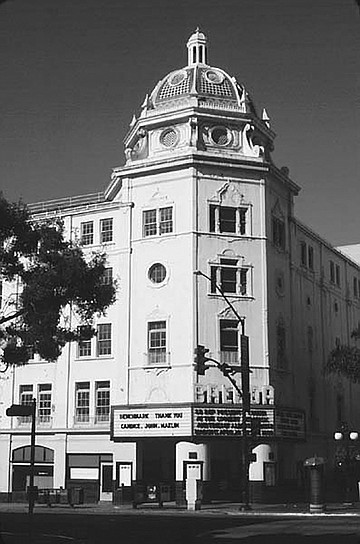 (Courtesy SD Historical Society)
(Courtesy SD Historical Society)
As with many theater stages, the Balboa's had a "doghouse" on top, with windows that opened up in the event of fire, to suck out heat and smoke. "It was an 80-foot drop from the catwalk grid under that doghouse to the stage floor," says Whitehead. "On top of the doghouse was a huge water tower. One day, a work crew came in to take that tower off from the roof. They were your usual bunch of know-it-all a--hole construction types. I told them the water supply to that tank was still live and that they'd better turn it off before they started cutting. They didn't listen. A little while later, the water started shooting up in the air and drenched everything. It looked like a tugboat coming into a harbor. I was laughing so hard that I couldn't get my breath."
Whitehead says one of the best things about working the Balboa was access to the balcony, closed to the public for years (mainly because the exits led to the closed-off hotel hall). "I dragged an overstuffed chair and a couch up to the front row of the balcony. My brother David, who later managed the Balboa, helped me lug them up there. It was, literally, the best seat in town, centered to the screen horizontally and vertically. Just a wonderful place to watch a movie."
The all-but-abandoned balcony was just one of the Balboa's backstage remnants of a vanishing era. "There was an old sign behind where the stage was, instructing silence on account of radio broadcasts," says Whitehead. "I've always wondered which local radio station it was. I'm betting it was KOGO, but no one in management knew. I think the broadcasting was probably done from a room up on the top floor of the hotel, which has a ceiling window and looks like a classic studio."
Out in the seats, the Balboa was at that point so infested with rats that, in quiet movie moments, you could hear them scurrying amongst the treasure trove of discarded snack bar confections. "There was a time when a lady jumped to her feet screaming because a rat had run across her foot," recalls Whitehead. Some other patrons were more scary than scared. "I recall a creep who had secreted himself in the janitor's closet in the women's restroom and was peeking out to see what he could see," he says. "There was another guy who used to rattle the plastic from his candy, just to irritate those around him. There was a huge, fat Mexican guy who sold newspapers on the street that we had to ask to leave more than once, because he smelled so bad."
Despite the descent into skid-row schlock, which mirrored Hollywood's own, the Balboa still frequently screened to packed houses, as when Star Trek: The Motion Picture debuted in late 1979. "Walnut had just bought a Dolby stereo sound system, and they rushed installation just for that movie," says Whitehead. "I put a strobe light up in the pinnacle on top of the Balboa's roof dome, and you could see it all the way up Fourth Avenue. Getting that tiny light on top of the dome wasn't easy. I had to climb up it from the outside. Had I fallen, I'd have gone straight down into the huge fan that exhausted air out of the house."
The Balboa also briefly flirted with 3D screenings. "As far as movie theatres are concerned, the very best 3D used two projectors locked in time with each other by devices called selsyn motors," says projectionist Dan Whitehead. "Cinerama used the same setup. Both projectors had to project the same frame of film at the same time. If one of the reels broke, blank film had to be inserted so that the frame count was the same on both reels. The screen had to be a silver screen. The Balboa has a silver screen that was flown up above the white screen. The 3D shown at the Balboa had both the 'negative' and the 'positive' frames in one frame of film. There were two types of that kind of film: side-by-side and top-bottom. I can't remember what type was used at the Balboa. The 3D lens was literally spit into two seperate elements in one lens. It cut the light output of the lamphouse almost in half and showed a rather dim picture."
Whitehead particularly recalls a 1983 3D "classic" called Metalstorm: The Destruction of Jared-Syn. "That was probably the very movie that caused the installation of a silver screen at the Balboa. I know there was something 3D that caused that to happen and Metalstorm may have been it. That's an entire story in itself which I'll go ahead and tell now."
"Tate, in an effort to save money, sent this outfit down to silverize - read, paint - the screen for 3D movies. 3D can be shown on a matte screen, but you get much better results with silver. They utterly ruined the screen; it looked like a mildewed bed sheet. Tate was really pissed, never mind that it was pretty much his fault in the first place. We wound up with a brand new white matte screen and a brand new from-the-shop real silver screen to boot. As I say, it was flown, and I always intended to motorize it, but it turned out to be one of those never-got-to-it projects and was only used once or twice as far as I can remember. Metalstorm had to be one of those two times, since we were out of there in '85."
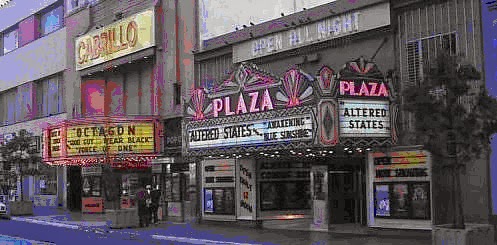
Among the many ways Walnut saved money was by endlessly cycling the same tattered film prints through all of its theaters, with popular movies serving as perennial backup features, even though many of the reels were damaged or even mislabeled. "We had a lot of questionable prints from a film distributor named Ray Hackie. Many films came from him that had the leaders and tails on the wrong reels. Many times it was because some projectionist somewhere had cut them off for their automation system and left no identifying frames on them so the next projectionist would be unable to check to see if the leader/tail was the right one for that reel. I wonder if he's still in business?"
"One time, he tried to charge us for a print we supposedly damaged. I was really pissed off about it, 'cause most of the films we got from him were extremely shitty and usually we sent them back in better condition than when they arrived. So I pulled together all the film inspection reports we had showing how many bad, messed up prints we'd received from him, had them all copied and sent them to him. We never heard any further about the 'damaged' print."
One notable thing about Walnut's theater tenure downtown was the way they followed the previous Aztec and Casino operators' lead by maintaining snack bars open to the public on the sidewalk, so passersby could smell the popcorn and buy a bucket for themselves. "You know, originally the Balboa had no concession stand at all," recalls Whitehead. "Neither did the Cabrillo or the Fox [later Copley Symphony Hall]. I'm not sure about the California. The place which is now the concession stand at the Balboa was originally the last few rows of seats in the auditorium. Same with the Cabrillo. Most of the theaters built in those days had no concession stands at all. My first teacher in the projection booth, Mr. Leslie Immel, said there were people, usually girls, who walked through the auditoriums selling candy and cigarettes out of a tray. I guess he knew what he was talking about, since he started working in movie theatres during the silent movie days. The Strand [in Ocean Beach, also briefly a Walnut Property] was also built with no concession stand. You could see, if you looked close, that it was a boxed-in add-on."
Food was a popular Walnut side investment. By 1977, Vince Miranda's Backstage Restaurant was operating in the Commodore Hotel at Third and F, adjacent to the Pussycat on Fourth. Restaurant patrons had to walk through the Pussycat's lobby to use the Backstage restrooms. "The Backstage was opened by a friend of mine named Frank Clancy," explains Whitehead. "Frank spent many long, hard hours getting that place opened, but then something happened. Wortman said something to Miranda that got him all stirred up and got Frank fired. Wortman took the place over and acted as if it was all his idea...I never did like [manager Don] Wortman. He had a heavy black beard and would talk out of the side of his mouth. He always made me think of a pirate." Wortman had known Miranda in the Coast Guard.
Frank Clancy's version of the Backstage was actually the restaurant's second incarnation. Clancy recalled the circumstances in a July 2008 email to Whitehead. "I seem to remember that Tate told me that it had opened when the theatre was legit [but] there were problems and Walnut closed it. When I opened it, the theatre was [screening] Deep Throat, [it] was I believe '75 or '76. They needed to get the restaurant re-opened, so that they wouldn't lose their liquor license. If you recall, I opened one day a month during the setup period, to keep the license active. I'd do all of the cooking, waiting, everything that day."
Whitehead picks up the story. "Frank Clancy literally put the [second] Backstage together from nothing. He ordered and oversaw the installation of everything and hired the first crew. I was with him the day he bought the sound system for the place from Dow Sound City, on El Cajon Boulevard. I remember it clearly. It was a powerful Sony with Bose 901 Series II speakers. I stole the entire system after the place closed for good and it belonged to the city, and I had it for years too, but that's another story."
"After the place [Backstage] got opened, business was just terrible. The cast and crew were very discouraged and were going to walk out. Frank took them all in the kitchen and served drinks on the house and gave them a pep talk to cheer them up; he was always very good at that kind of thing. Someone told Don Wortman about it -- I'm betting it was Charlie Combs, who later married [former Hollywood Burlesque owner] Bob Johnson's daughter DeeAnn. Don Wortman got Mr. Miranda all riled up about Frank giving liquor away to the employees for free - never mind that this kept them from walking off the job - and Mr. Miranda fired Frank himself."
Don Wortman was murdered in 1981. After Wortman's death, Miranda moved his own room at the Hotel San Diego from the sixth floor down to Wortman's former suite in room 264. Miranda installed former waitress Donna Martin as the hotel's resident manager. "Donna was quite a character," recalls Whitehead. "She and Mr. Miranda loved to drink. I remember drinking with them one time when she was waxing eloquent on the fact that God was actually a woman. One morning for breakfast, I went down to the Country Kitchen with Tom Wimbish [manager of the Cabrillo, Plaza, and Balboa theaters]. Mr. Miranda and Donna joined us, and they had both lost their voices from drinking so much the night before. Mr. Miranda was trying to figure out if it was the vodka or the cigarettes that did it."
Among the dozens of mostly-Hollywood related photos in the Hotel San Diego lounge were vintage looking pictures of both Tate and Wortman dressed in military uniforms. “That picture of Mr. Tate in the Navy uniform was staged,” reveals Whitehead. “I think there was one of Wortman in a military uniform too. Only Mr. Miranda was in the military. One thing I do know for sure is that Georgie [Tate] was in the Army. He was stationed down in Alabama or Georgia and contracted spinal meningitis and was in the hospital down there. I recall my aunt Lillian going down to see him as he was not expected to live, but live he did.”
Whitehead recalls “The hotel that was above the Lyceum/Off Broadway/Cabaret was the Commodore, and [Aztec Theater owner] Wes Andrews – AKA Andy - ran it for a while. In fact, he moved his office of operations out of the Aztec and into the Commodore, and then to the southwest corner of the 10th floor of the St. James after that, rooms in which Tom Wimbish lived for a while.”
“I nicknamed it the Commode Door, which caught on like wildfire. Andy was not pleased, but it was too late.”
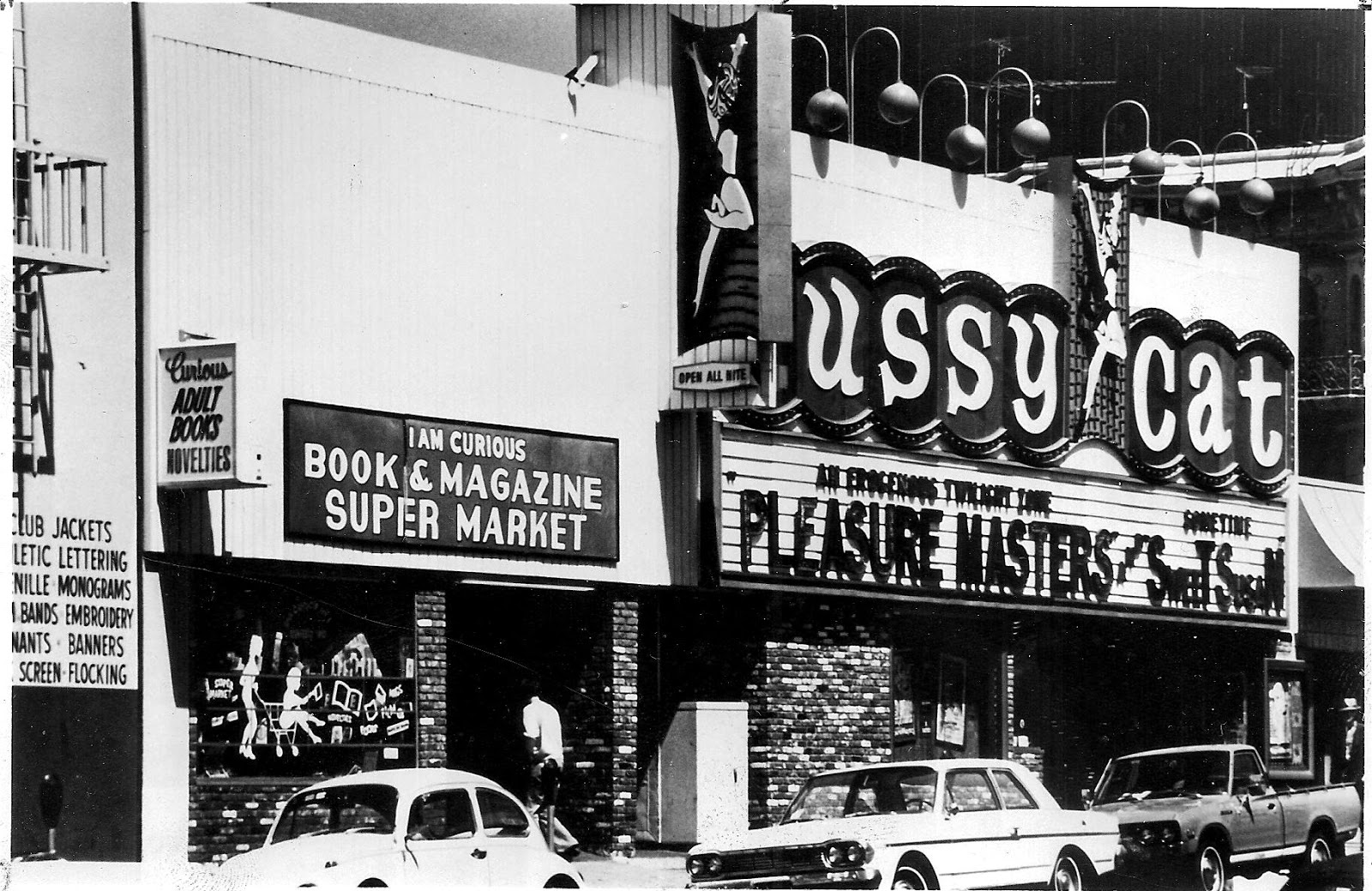 (San Diego Pussycat on 4th Avenue, March 1977)
(San Diego Pussycat on 4th Avenue, March 1977)
Downtown's Pussycat on Fourth Avenue -- open from noon-5:30 a.m. daily -- was notorious for sidewalk posters that assaulted passersby with graphic (not quite explicit) images from triple-X features with titles like Talk Dirty to Me, Taboo, The Budding of Brie, and A Scent of Heather. The decor was mildly seedy, if era-apropos: faded and cracked tile offset by chrome-etched mirror panels and lit by flashing red and purple lights.
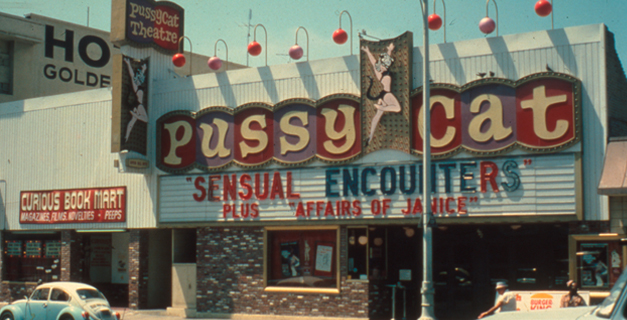
Whitehead recalls opening Deep Throat at the downtown 'Cat, where the film would screen almost continuously over the next five years. "I worked for three days straight, because the day projectionist, Michael Knight, was a college student and afraid of getting busted; he later became management. Those were 18-hour shifts, back to back. After the third day, I literally couldn't go on any longer and went home and crashed."
"That was the night the vice squad came in and confiscated the print."
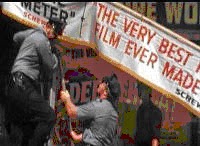
Walnut's head of public relations, Don Haley, was staying in town and prepared. "He brought a second print over from the St. James Hotel -- the cops could only take one print until a court decided if it was obscene -- and then he proceeded to call all the radio and TV stations in town. When I got to work the next night, people were lined up way down the street and around the block, and it stayed that way for a long time. It was so busy that we were answering the phone in the projection booth, because the concession stand and box office were literally too swamped to do it." Walnut battled the city over this and other Pussycat matters for years.
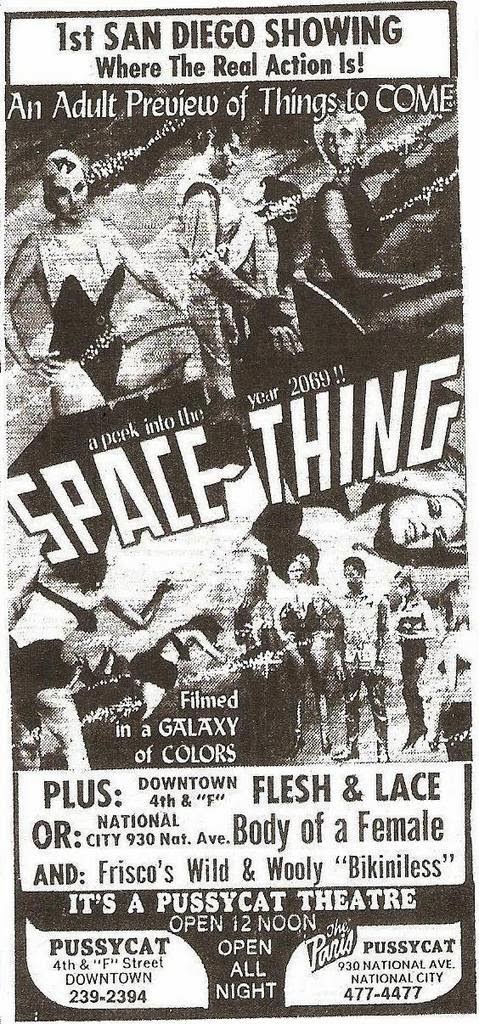 (9-4-68 courtesy San Diego Cinerama)
(9-4-68 courtesy San Diego Cinerama)
Miranda and Tate had actually purchased the entire California Pussycat Theater chain from its original founders. Whitehead sometimes worked at the Los Angeles Pussycats, including one that operated over the Masque punk club in the basement of the Hollywood Pussycat Theater, where the Go-Go’s played their earliest gigs in the late ’70s. “They broke the building elevator trying to get a cow down into the club,” recalls Whitehead. “It was an old-style elevator with the large up-down handle once cranked by operator, and the car had lots of brass…. [The owners] were very angry about that, and even more upset when they couldn’t get a permit to restore it and wound up with an ugly, sterile, broken elevator.”
“A murder happened in the club and, after the police left, the chalk outline of the body was painted with Day-Glo paint. It was still there the last time I was in the building in 1989, after the club was gone.”
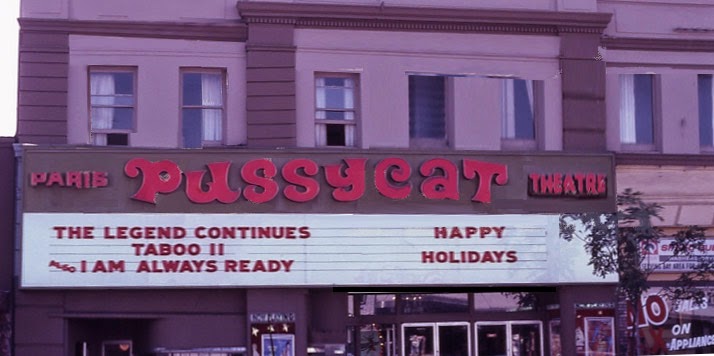
Whitehead also found himself occasionally working at National City's 'Cathouse. "I personally ran the Paris Pussycat booth many times," says Whitehead. "The projection booth was originally the balcony. In the late '70s, that was the very first booth where Walnut tried a homemade automation system. Each feature was on one big reel. Projector number one had the main feature, and projector number two had the second feature. The lamp-houses were Peerless Magnarc carbon arc lamps, which had been converted to xenon. The upper reel -- the supply reel -- had a motor to rewind the feature, and the take-up reel had a separate motor to drive it, because the reel would become too heavy for the soundhead take-up drive to manage. I installed a completely new automation system, sound system, projector heads, sound heads, lamphouses, and rectifiers."

Walnut withdrew from managing the Paris Pussycat in the mid-'80s. Former Aztec Theatre owner Wesley "Andy" Andrews leased the property from Walnut and kept it open under the Pussycat name until 1999, after all but the last few California 'Cats had closed.
The 4th Avenue San Diego Pussycat and the nearby X-Rated Cabaret (formerly Miranda’s legit Off Broadway Theatre) were the first theaters Walnut automated. “One projectionist ran both houses. It was actually semi-automation as it was a two-reel automatic changeover system instead of using a platter system. I was the guy who later installed the automation systems in all the other downtown houses. If I had it to do over again, I'd have urged them to go platter instead of reels.”
 (2-18-68 courtesy San Diego Cinerama)
(2-18-68 courtesy San Diego Cinerama)
One early Pussycat regional manager in San Diego was Yugoslav immigrant Gojko "Greg" Vasic, who'd later borrow money from his parents to launch his successful F Street Bookstore chain. "Vasic was the longest lasting of Walnut's district managers," reveals Whitehead. "He still worked for Walnut after he opened his first F Street store across the street from the Cabaret [formerly Miranda's legit Off Broadway]. Mr. Tate was very fond of him. He was certainly a strange character. His family name was actually spelled Vasich, and they used to have an egg ranch in Ramona. His uncle delivered their produce to many of the downtown eateries."
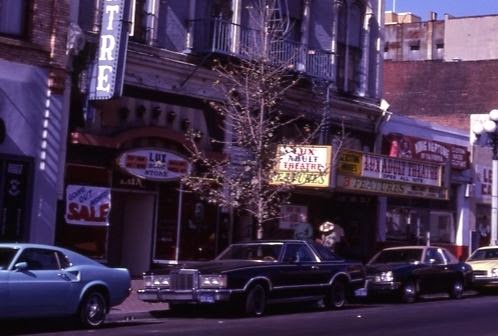
Downtown in the late 70s included over 30 adults-only businesses, mainly porn theaters, adult bookstores, and peep shows. “John Antonelli owned the Lux Theatre just underneath the Neptune Hotel,” recalls Whitehead. “His brother Andy Antonelli ran Sonny's on the west side of 5th, with Andy [Wes Andrews] and Charlie.” The Lux was later purchased by Rick Ford who also operated a porno filming place upstairs in the Neptune that he called Seabag Productions. “Bob Smith was a guy who used to own the Little Hollywood, which was on G Street between 4th and 5th under the New Kelsey Hotel. Smith and Wesley Andrews were arch enemies and I never really did know why."
"Smith also owned the Bijou - formerly called the Savoy - and I think he called it the Cinema X. Smith owned a lot of places at one time or another. He owned a huge gay club down on PCH called the Ball Express. He'd open a business, milk it for everything he could get out of it, and then move on to something else.”
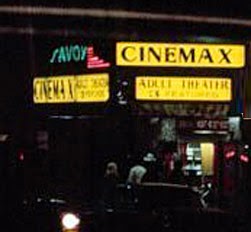
Smack dab in between Walnut’s Casino and Aztec theaters on 5th Avenue – both of which occasionally served as X-rated Pussycats - was a disreputable little cave called the Foxy Theater, where some Walnut employees moonlighted in the late 70s. “The Foxy,” recalls Whitehead, “now that was one nasty, dirty place. Bob Clark owned and ran it with his squeeze, a guy named George, can't remember his last name now. Bob died a few years ago. He'd become real fat, like around 300 or 400 pounds - no kidding! I'm surprised he lasted as long as he did, 'cause he had a real nasty temper too. He had another [porn] place out in either Spring Valley or Lemon Grove.”
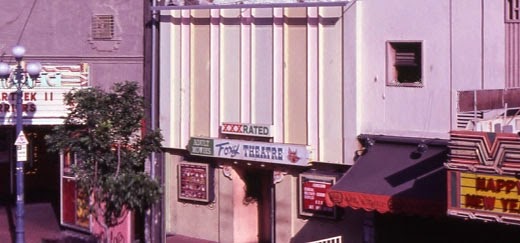
As downtown San Diego became increasingly seedy, Walnut's grindhouse theaters began opening at noon and closing at midnight. "They were finding needles in the alley behind the Casino," recalls Whitehead. “One time when my brother David was running the Casino projection booth, they were closing and couldn't get this old guy in the balcony to wake up, and it turned out he’d had a heart attack or something and died. Another time, they found a dead guy out behind the rear exit doors. He'd crawled into a fenced in area and had probably died in his sleep several days before, so he was pretty ripe, which is how the manager found him, from the smell.”
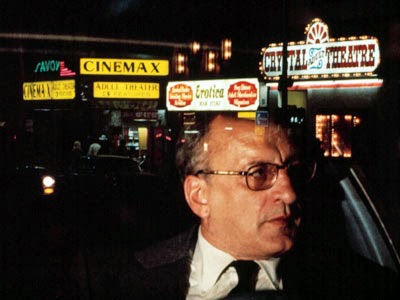
The 1979 film Hardcore shows downtown at its Sodom and Gomorrah peak, with George C. Scott stumbling through wall-to-wall porno shops in search of information about his missing porn-star daughter. He makes his way down Fourth and Fifth Avenues, dodging hunchbacked junkies and drooling perverts at every step. "There are some fantastic shots of 1979 downtown San Diego [in Hardcore]," notes Whitehead. "Places I'd all but forgotten. Great shot of the Pussycat on 4th. Also a fantastic shot of the Aztec."
You can see the Cabrillo and Plaza during their final days in the 1980 Marty Feldman film In God We Trust, partially shot downtown. "They took one of the box-office ladies named Olivia and put glasses and a wig on her," recalls Whitehead. "I think I ruined one of their shots. The Cabrillo paged me with an emergency, and the film crew tried to keep me from going in. I just pushed past them and went in anyway. As far as I was concerned, there was an emergency, and Walnut was paying my check, not them. Asshole me, ha?"
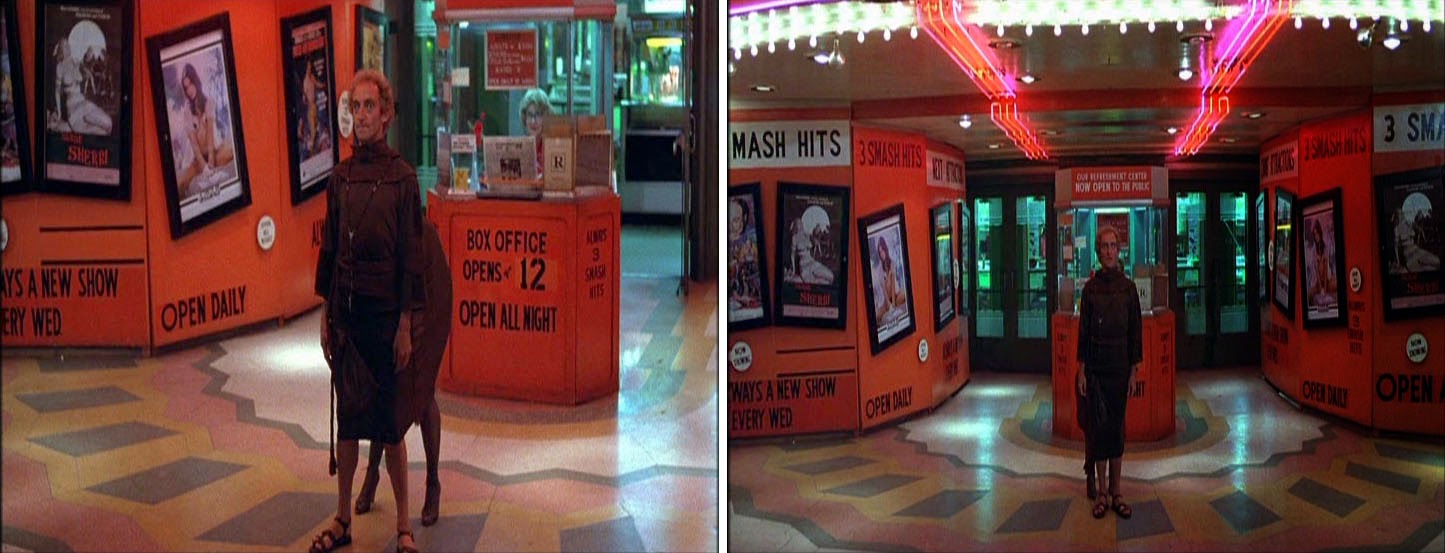 (Cabrillo as seen in the 1980 Marty Feldman movie In God We Trust)
(Cabrillo as seen in the 1980 Marty Feldman movie In God We Trust)
The City of San Diego ended up taking over several Walnut Properties by using eminent domain. "Talk of the city taking over the properties had been around for a while," recalls Whitehead. "I had to deal with people from the city from time to time, as they came to inspect the properties they were basically stealing. Eminent domain operates under the 'color of law,' but it's theft, pure and simple. No private citizen can operate in such a fashion, so it shouldn't be legal for the city government to do it. I never had anything but cold, utter contempt for the parasites that made up the San Diego City Council and the CCDC [Centre City Development Corporation]. They were and probably still are smarmy, self-righteous tax parasites. Anytime I could cause them any trouble whatsoever, no matter how small, I went out of my way to do so."
"One time, the CCDC sent two architects to inspect the Balboa, so that they could declare it earthquake unsafe and make it easier to steal. These guys were in their late 50s or early 60s, and I made them go through that entire building, from the theater to the hotel, and the stores. I took them through every crawlspace and airshaft that one could fit into. We started at 9:00 in the morning and didn't finish until that afternoon. By the time we were done, they were literally drenched with sweat and hardly had any strength left at all. God, I hated those motherfuckers."
"The guy I had the most dealings with was a runty little weasel named Dave. One time, he browbeat Angie, the Filipino gal who was temporary manager of the Balboa. She was one of the most kind, gentle, sweet little gals I've ever known. At Mr. Tate's orders, I had copied a set of keys to the Balboa and the Pussycat for the CCDC's little Napoleon asshole. The key that worked the door to the Balboa's dome didn't work, and this creep verbally browbeat Angie and told her to get that door open or he'd have it knocked down. She paged me in tears, and I called him and told him to deal directly with me only from that point on. Then I made him wait a few days for a new key."
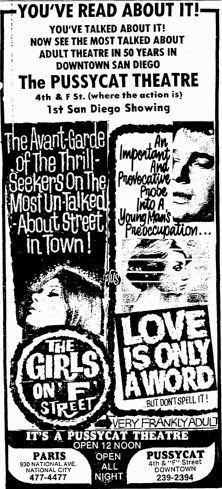
Next, time was up for the Fourth Avenue Pussycat. "On the day we removed all the equipment," remembers Whitehead, "I was instructed to give a guy from the city the keys when we were finished. So I called and he was there in just a few minutes, as if he'd been waiting right beside the phone or something. I had removed all the identification from all of the keys, just to make his job difficult. When he put out his hand for the keys, I deliberately let them fall to the floor, turned my back on him, and walked out the door without a word. Yes, that was small and petty, but it felt good to do it."
 (4th Avenue Pussycat on its final day)
(4th Avenue Pussycat on its final day)
As more theaters closed and others reduced their hours, layoffs were becoming a chain-wide epidemic. “I remember a meeting one time when Tate was shutting things down and deciding who to get rid of,” says Whitehead. “There was a woman at the Ventura Theatre who'd been there fifteen years or more. He said 'Oh, get rid of her, just get her out of there,' as if she were just a piece of broken furniture. That was Tate through and through.”
That said, however, Whitehead notes “As greedy as Mr. Tate was, there are three things he did do for me. First, on his say-so, Walnut loaned me the money for a car I wanted, a 1972 Mercury Cougar, which I paid back in full. Then, Walnut paid for some extensive dental work I needed and, after I'd done some from-scratch booth installations, they wrote off the $1,000.00 balance I owed for that dental work. That writing off of the $1,000.00 balance owed caused some petty sniping at the office, never mind that the hard work I did all on my own saved the company many times that amount.”
Vince Miranda died June 3, 1985, after battling lung cancer in an L.A. hospital. The IRS hit Miranda's estate with a federal tax lien of $6,047,760.00. Walnut properties all over the state were sold, leased, or traded away, with many real-estate holdings being handed over in lawsuit judgments. Several claims against the estate were connected to ongoing litigation dating back years. Walnut Properties and/or company principals were served with over 100 civil lawsuits filed between 1973 and 2005, the majority related to Pussycat locales. In all, around $30 million in Walnut assets were liquidated, lost in judgments, or "gift deeded" to others over the next 15 years.
A woman named Brenda Farley also won a lot of judgments against Walnut, apparently relating to outstanding payment due, as well as money she’d loaned the company. “Brenda Farley was married to a German guy named Hans,” recalls Whitehead. “She owned a construction company for him, and Hans was applying to be a legal citizen. They did a lot of work for Walnut, but then there was some sort of flap about a check for a lot of money to repair the elevator at the St. James Hotel disappearing. It seems to me that it was about $15,000, give or take, so there was a big falling out between them and Walnut.”
The Balboa closed in the first week of April 1986, with over a decade remaining on Walnut's original lease. The final double feature on its screen was April Fool's Day and the Stephen King film Silver Bullet (based on his book Cycle of the Werewolf). "I don't remember much at all about the last day," says Whitehead. "This may sound silly, but it was a sad, even traumatic, experience. I loved that house very much; it really hurt to leave. My office was there, and I ordered all the projection booth parts and supplies from there, and everything for my department was delivered there."
Whitehead was by this time managing the Star Theater in Oceanside, as well as running the booth on weekends at the Aztec and Casino. “There was a very short period of time when the Aztec was closed. It was for legal reasons, as they were setting up a dummy corporation. A guy named Terry Wiggins leased the Aztec, Bijou, Casino, El Cajon [formerly the Pussycat El Cajon], the Star in Oceanside, and the Plaza in Carpinteria from Walnut."
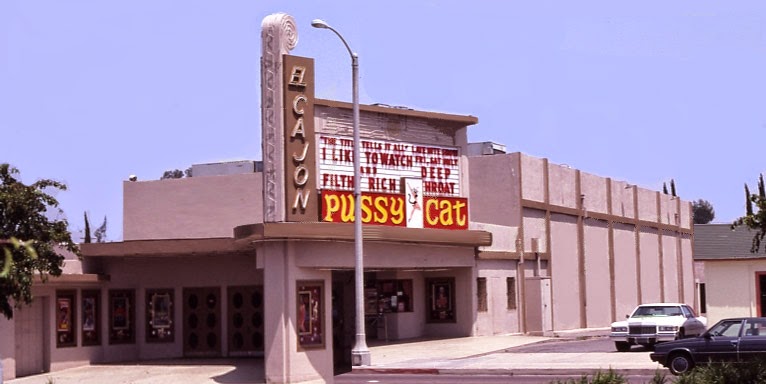 (El Cajon Pussycat, July 1983)
(El Cajon Pussycat, July 1983)
Whitehead reveals “The name of the dummy corporation that was set up [by Wiggins, for Walnut] was Star-Crest Theatres, named after the Star and Crest theatres in Oceanside. I can't remember if the Aztec was under that umbrella or not. The name of Terry Wiggins' later company was TRW Theatres, and he ran the TRW theaters as his own, without Walnut, ‘til his company shut down in April of 1994.” Whitehead worked for Wiggins from 1989 through the 1994 company closure. “Of course, I'd been responsible for all of the above houses for Walnut and just phased out of Walnut and right into TRW Theatres. For a while, I was on both payrolls, which was real nice while it lasted.”
“Terry won't talk about any of that past, and I can't get him to change his mind. He also managed the Torrance Pussycat before [Vince Miranda's aunt] Mrs. Johnson, long before he and I met. He was Walnut's district manager from about 1983 'til about 1988. He was Walnut’s next-to-the-last San Diego District Manager, followed by a husband and wife team, Mr. and Mrs. Polydorous.”
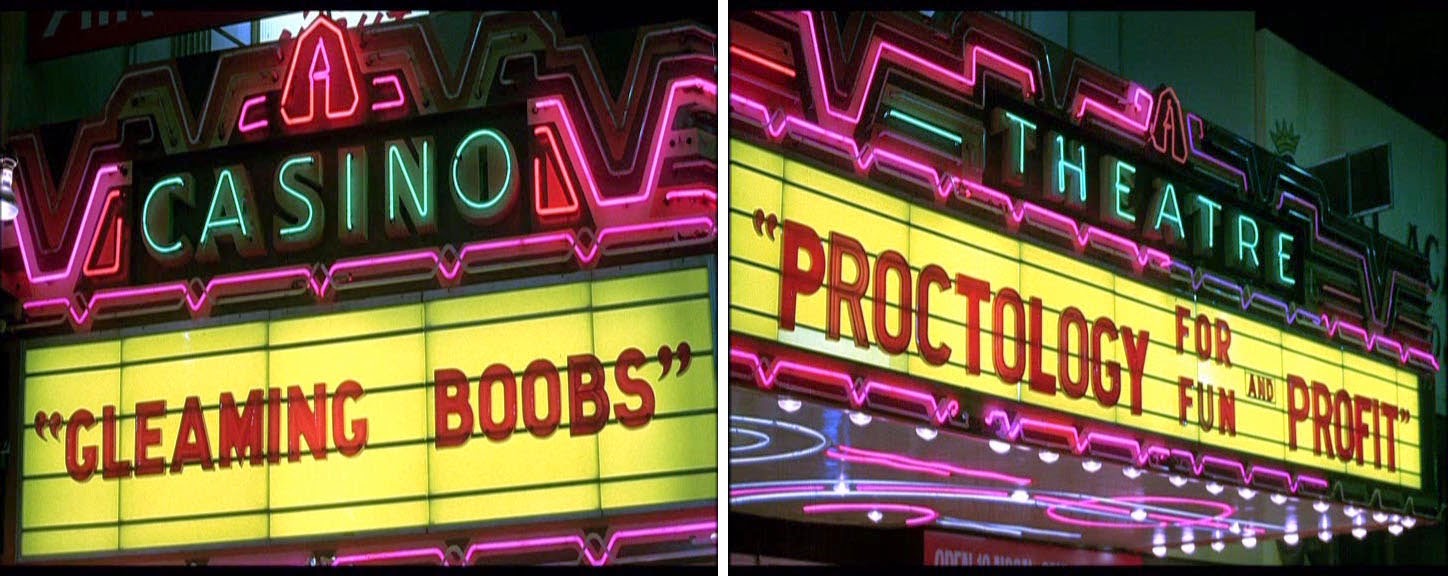
“There was man named Bill who took over the Aztec and Casino before Terry [Wiggins] for a very short time. I remember that he took the Dolby stereo sound system that I'd removed from the Balboa, speakers and all, to a theater up in Tulare. He also took a custom made desk that had been crafted by a nephew of Andy [Wes Andrews]. That pissed me off. I don't know why, 'cause it wasn't my property, but it really did piss me off. He had a partner who looked about as Mafia as anyone I'd ever seen.”
Also stacking the deck against operator Wiggins, “The guy who managed the Plaza Carpinteria ripped Terry off real bad. In fact, I think it may have caused the downfall of TRW Theatres, along with the scum from the IRS.” With Walnut embattled on so many fronts, the stress cracks began to show. Wiggins and Whitehead both seemed to share increasing disdain for George Tate, though Miranda remained high in their esteem throughout this turbulent period, which saw a lot of shakeups among management.
“When Tate and his cohort Ted Morris would come to town, they'd stand around stroking their chins like crafty old pirates. Terry Wiggins and I dubbed them ‘slip and slide.’ Talk about no respect for our employer! If [latterday Pussycat partner Jonathan] Cota was with them, it was ‘slip, slide, and slither.’ Boy, were we bad, but no one could stop us. We both were too good at what we did. They'd never have found anyone to do our jobs as well as we did for what they paid.” Whitehead’s association with the theaters previously operated by Walnut did finally end. Those experiences essentially became memories when Terry Wiggins got out of the theater biz.
Says Whitehead, “It was the closing of a very long and important chapter of my life.”
In 1987, Walnut (under George Tate's stewardship) sold the Hotel San Diego for $6 million to Dr. Leonard Glass, whose purchase also included a 99-year ground lease for the entire block (Glass also took over the El Cajon Pussycat Theater). "Around then, my paycheck bounced for the first time," recalls Whitehead. "It wasn't long after that that I was let go." Walnut Properties filed Chapter 11 bankruptcy actions in June 1994, listing liabilities of $17.7 million. George Tate passed away soon after.
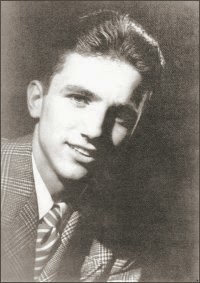
Shown the above photo of young Tate (courtesy Tate's cousin Gordon Walker), Whitehead notes “Funny that such a handsome face could hide such a greedy soul. On the other hand, it was Mr. Tate who wrote off the $1,000.00 I owed them for dental work they'd paid for me. I asked if he would forgive that debt as a bonus after the Fresno installation was finished, and he did it immediately.”
Then again, “Ethel [Edwards, Walnut’s L.A. office manager] told me that, for a while, she used to cook meals for Mr. Tate's mother, not sure of the time frame, and Mr. Tate never paid her for doing so. Apparently, Mr. Miranda found out about it and saw to it that Ethel got paid.”
Whitehead took a job for a while with Edwards Cinemas, and then retired, moving off to a movie-filled home in Texas. He recalls knowing other local projectionists during his time in San Diego, including one of the operators of the Valley Drive-In, which battled the City of Oceanside for years over things like its weekend swap meet. In August 1986, Valley Drive-in manager Jerry R. Beauchamp went so far as to file for a seat on the Oceanside City Council. He withdrew from the race a few weeks later, choosing to instead support candidate Paul Wick, a 50-year-old businessman who had been living in Oceanside for 25 years.
"Jerry Beauchamp was one of the union projectionists at the Valley Drive-In," recalls Whitehead. "He also did relief work at the Crest, Palomar, Star, and Towne theaters when Walnut had them. I always liked him. He put me in mind of a hefty, good natured southern sheriff." Regarding the Valley's municipal battles, Whitehead says "You know, there is no longer any respect for private property. Really hasn't been for a long time. That Oceanside City Council is a smarmy, self-righteous downright sickening bunch. I attended a couple of their meetings with a group from my neighborhood to protest the gang activity that was beginning to take place there."
"They sit on a high dais and the lights dim up. Very theatrical. It made me want to puke. I even wrote a little piece that would up in the Oceanside newspaper in which I stated that the new City Hall was more like a theater and could possibly be put to better use were it rented out to troubadours, minstrels and traveling theater companies. I typed and printed copies in my office at the Star Theater and left them in a pile in the city hall lobby with my signature affixed. I was pleasantly surprised when it showed up in the paper." The Valley stopped screening movies altogether after the 1999 season.
Among the theaters outside San Diego where Whitehead did work for Walnut was North Hollywood's Guild Theater at 5161 Lankershim Boulevard, designed by architect S. Charles Lee, opened in 1938 and had been known as the Valley Theater. By early 1977, the Guild was a Pussycat. “The Guild was constantly having automation problems,” he recalls. “The system they had was an early Chrisite AM-type system, actually built by Kelmar. After I got done addressing all of its problems, I may have known more about it than anyone in the business, including Christie and Kelmar (just a joke). The manager was a guy named Bill Carol, who later became an assistant to the purchasing agent, Ron Naslund. I liked him; like me, he had a jaded, slightly twisted sense of humor.”
“His girlfriend's name was Gay. His father was a bit of a homophobe, and didn't even like to say her name.”
Whitehead recalls “One time I was down in the basement of the Hollywood Center Building with Mr. Miranda and [Walnut exec] Ron Naslund. There was a big project cooking to get that basement cleaned up. Mr. Miranda opened a locked room that had belonged to one of the long-gone tenants of the offices upstairs. It was filled with porno magazines. Mr. Miranda said ‘You just can’t get away from it, can ya?’ I thought that was an odd thing for the porno king of California.”
Whitehead has fond memories of many of his former co-workers, even though many of them are gone now. "Charlie Smith, business partner of Wesley 'Andy' Andrews died in 2012. Unless Daryl Edwards is still living, I'm the very last of that circle. Can't remember if I mentioned that before or not."
He also fondly recalls Walnut employees such as “Paula Miranda - no relation to Mr. Miranda - was the long time District Manager of the northern district, and her office was in one of the Sacramento houses. After I'd de-unionized and cleaned up the Pussycat Guild in downtown San Francisco, she wouldn't let anyone but me work on her booths.”
Whitehead also remembers Vince Miranda's aunt Ada Johnson, who managed the Pussycat in Torrance (formerly the Stadium Theater), at 1653 Cravens Avenue, where tenth-grade dropout Quentin Tarantino checked tickets and manned the snack bar in the late '70s. "I was up there several times on service calls," says Whitehead. "Ada Johnson, managed this and the Lakewood Theatre at the same time. She was a great lady, and I was very fond of her. She didn't take any shit from anyone, anywhere, anytime, ever."
"Before Ada Johnson managed Torrance and Lakewood Theaters, she managed the Palace Theatre on Pine Street in downtown Long Beach. Like the Cabrillo, it was a grindhouse. Unlike the Cabrillo it was a very rough place. I can't remember when she left there to take over Torrance and Lakewood, nor can I remember when we closed the Palace. It was still ours in the early '80s as I serviced it several times. The manager was a big, burly gay guy named Dan. His squeeze was the assistant manager. I can't remember his first name, nor either one of their last names. I do remember that they always had excellent pot, and after I'd get done doing whatever it was I had to do, we'd go up on the roof and smoke a doobie and then I'd drive back to Hollywood very nicely stoned."
"Ah, beautiful pleasant memories of a long-gone California, a much missed era. I'm so very glad that I got to experience it."
Editor's note: Dan Whitehead suffered a heart attack in July 2023. He died at the hospital a few days later.


The pre-Gaslamp, premultiplex downtown of 1979 exists today only in the fond memories of cinemaniacs old enough to recall a time when Jaws made you afraid of the water, Friday the 13th made you afraid of hockey masks, and Star Trek: The Motion Picture made you afraid of sequels. Half a dozen eclectic — if mildly disreputable — late-night movie houses operated within a few blocks of each other in the midst of a seedy urban sprawl perfectly suited to the sailors on shore leave and porn aficionados that made up much of its foot traffic. A couple of bucks got you a double or triple bill, screened ’round the clock in cavernous single-screen movie theaters that hearkened back to Hollywood’s golden age, rich in cinematic history and replete with wide aisles and accommodating balconies.

Projectionist Dan Whitehead worked at most of the downtown movie theaters for over 20 years, beginning around Thanksgiving 1972, when he took a projectionist gig with Walnut Properties, who ran both Horton Plaze theaters, the Cabrillo and the Plaza. "We screened The Texas Chainsaw Massacre at the Cabrillo the week it was released in 1973," recalls Whitehead. "The house was packed for all but the earliest and latest showings. It made so much money that the studio jerked it out of our second-run houses and put it in the first-run theaters."
Walnut would take over the Aztec Theater on 5th Avenue, as well as running the Casino Theater down the block and the Bijou across the street, not to mention both the Balboa Theater on 4th, and the nearby Pussycat adult theater. The same duo behind Walnut, Vince Miranda and George Tate, owned the Hotel San Diego and the legit Off Broadway Theater downtown, the latter operating in the old Hollywood Burlesque building.
 (Dan Whitehead high school photo)
(Dan Whitehead high school photo)
"Mr. Miranda was a quiet and energetic guy. We got to know each other during the many drinking parties we had at the main office and at the Hotel San Diego," remembers Whitehead. "He had a motto that he had engraved on his license plate frame -- 'work hard, play hard' -- and that's what we all did. You could tell he really loved show business and loved movies and that it wasn't just a way to make money for him."
 (Miranda by JAS)
(Miranda by JAS)
"Tate used to be a movie extra," says Whitehead. "They supposedly met after getting into a car accident with each other. The story goes that Tate had a theater and Miranda had a restaurant, and they had no money to cover the auto damage, so they just went into business together." Miranda and Tate, who were lovers that shared a home, were both considered the bosses at Walnut, though Tate was seen less by most employees.

Whitehead got to know Tate while training at the Cabrillo. "He had a silver tongue and could probably sell anything to anybody, almost like a snake-oil salesman. He probably could have made millions in religion. My feelings for Mr. Tate soured many years later, when the company was shutting down and Mr. Miranda was dead."
 (Tate by JAS)
(Tate by JAS) (Dan Whitehead)
(Dan Whitehead)
Miranda acted as Walnut's public face, frequently mentioned and quoted in the local press by theater critic Welton Jones (a close friend), while Tate was rarely seen or referenced. According to Whitehead, "Tate liked to stay in the shadows. He was always so secretive. There were those of us who wondered if it wasn't really Tate who actually owned the company, and Miranda was just a figurehead. The rumor was that Tate's real name was George Munton and he'd been in some serious trouble having to do with child molestation and couldn't legally own those X-rated houses. That rumor never went away and was told to me by two people who'd known him for many years."
 (Whitehead by JAS)
(Whitehead by JAS)
Miranda and Tate wanted to be downtown's biggest -- if not sole -- grindhouse operators. Walnut purchased a 22-year lease on the Balboa and bought the Casino Theater outright. However, the Russo family who operated the Aztec held on to the Fifth Avenue theater, at least for a while. In 1973, two independent operators -- Charlie Smith and Wesley "Andy" Andrews -- purchased the Aztec property so desired by Walnut. Whitehead ended up quitting his job working for Miranda and Tate to spend a few years as the Aztec's daytime projectionist. "Andy and Charlie's motto on the west reader board of the marquee read 'It's first run 'til you've seen it!' This was actually the brainchild of the night projectionist, Henry 'Hank' Le Clair."

The Aztec was previously run by Russo Family Enterprises (later called El Dorado), until purchased in 1973 by A&S Theater Corporation, owned by Smith and Andrews. The duo had previously run a 16mm X-rated house called the Little Art at the southeast corner of Third and E Street, where they reportedly earned the money to buy and remodel the Aztec. Smith and Andrews reopened the Aztec on January 23, 1974, screening a triple feature that included Paint Your Wagon and The Friends of Eddie Coyle with Robert Mitchum.
"The concession stand had a counter open to the public sidewalk," recalls Whitehead. "Andy and Charlie kept the snack bar stuffed with food and candy, and they even bought a pizza oven and served individual slices of pizza. They had chili for a while, and those wrapped sandwiches you heated in an oven. A lot of downtown hookers and hustlers used the Aztec concession stand as their diner."
The Aztec was known for oddly mismatched double, triple, and even quadruple bills. "There were a few that played there that seemed out of place," says Whitehead, "but then, that was the charm of the place. Andy was a good merchandiser. A couple times, during major holidays, we would run five and six features. On those ocassions, there were not enough house reels and we had to run off the shipping reels, which made the reel end alarm bells inaccurate as the hub of the shipping reels was smaller in diameter than the hubs of the house reels. Good memories."
Walnut and Smith/Andrews - though competing theater operators - eventually warmed toward each other. "Even after I went to work for Andy at the Aztec, I spoke often with Mr. Tate at Walnut," Whitehead says. "I introduced Andy to [George] Tate in 1974, and they became fast friends. Andy leased the Commodore Hotel at Third and F from Tate sometime in the mid-'70s and moved his office there. He was always doing stuff for Walnut. In fact, Andy ran the Hotel San Diego for them for a while." Other downtown inns snapped up by Miranda and Tate included the Clark Hotel and William Penn Hotel on Fifth and the Hotel St. James on Sixth.
Whitehead went back to work for Walnut as the chain's head San Diego projectionist in 1978. "I had a real mess on my hands. The head projectionist had done a lot less than he could have, as far as routine maintenance was concerned." He says the frequent post-shift "drinking parties" with Miranda resumed ("He really liked to drink").
Walnut finally managed to buy the Aztec Theatre, running it as a sister operation to the nearby Casino. The Casino, in the middle of the block and across from the Savoy Theatre (later Walnut's Bijou), was around a half-century old at the time. It was in decent repair, with a full-length balcony that was actually open most of the time. "They ran a little restaurant built onto [the theater] called Loren's Q," remembers Whitehead, "and they had some delicious barbecue. They also served these teeny, tiny little hamburgers they called Q-burgers."
The Aztec also hosted occassional "World Premier" screenings, according to Whitehead. "The debut showings of two so-called 'Blaxploitation' features, Uncle Tom's Cabin (1976) and Dolemite (1975), were I think we billed as 'sneak previews,'" he recalls. "At the time, they were 'exclusives' showing only at the Aztec. I can't remember anything about how it happened that they screened for the first time anywhere at the Aztec and neither can Charlie Smith - I just got off the phone with him. It's most unfortunate that anyone who would remember, apart from Charlie and myself, are all passed away now. Dolemite is in my Netflix queue, but Uncle Tom's Cabin will most likely never, ever be found or even available. It was a terrible movie."
As for those and other "urban" features that tended to attract a racially mixed crowd, Whitehead says San Diego's Walnut houses were surprisingly trouble-free, at least compared to theaters in the chain closer to LA. "I don't recall there ever being any kind of racial issues of any kind, regardless of what kind of movies were playing. There may have been some words-push-shove incidents, but I honestly can't remember even any of those. I'm really glad you mentioned this 'cause I think perhaps we may have been a little bit ahead of the times. I remember when that movie Colors was released. The cops were prepared for all kinds of trouble, and I don't think there was any even then. All in all, it seemed that everyone really did 'get along' as it were."

Over at the Balboa on Fourth Avenue, Walnut used the grand olde girl to screen the same exploitative fare as its other grindhouses, marking what is to some an ignoble period for the one-time crown jewel of downtown theaters. "I was always fascinated by the Balboa and was determined to do my best by her," says Whitehead. "The first thing I did was go over every inch of her, from the roof to the basement."
Among the Balboa's most distinctive features were the waterfalls on either side of the room. "They were in enclosed chambers," says Whitehead. "The one on the left had a little entrance door you got to from the hotel, while the one on the right had no entrance unless you went and got a ladder. The switch that turned them off and on was in the projection booth. I hooked it up to the automation system so they'd turn on when the curtain closed and turn off as soon as the show started. The chambers filled automatically with a ballc-ck assembly filling up the pool at the bottom, just like in a toilet tank. A recirculating pump fed the water up to the top, where it cascaded back down."
Sometime after Walnut leased the building, a pipe in the second basement burst. "Nobody thought it fed anything that the theater used any longer, so the plumbers just cut it off. A couple weeks later, we realized that the waterfalls weren't working and the supply line had been cut. There was no way the company would spend the money to fix it. From that time until the theater closed, I used a ladder and hose to fill up the waterfalls myself, about once every week in the winter and twice a week in the summer."
 (Courtesy SD Historical Society)
(Courtesy SD Historical Society)
As with many theater stages, the Balboa's had a "doghouse" on top, with windows that opened up in the event of fire, to suck out heat and smoke. "It was an 80-foot drop from the catwalk grid under that doghouse to the stage floor," says Whitehead. "On top of the doghouse was a huge water tower. One day, a work crew came in to take that tower off from the roof. They were your usual bunch of know-it-all a--hole construction types. I told them the water supply to that tank was still live and that they'd better turn it off before they started cutting. They didn't listen. A little while later, the water started shooting up in the air and drenched everything. It looked like a tugboat coming into a harbor. I was laughing so hard that I couldn't get my breath."
Whitehead says one of the best things about working the Balboa was access to the balcony, closed to the public for years (mainly because the exits led to the closed-off hotel hall). "I dragged an overstuffed chair and a couch up to the front row of the balcony. My brother David, who later managed the Balboa, helped me lug them up there. It was, literally, the best seat in town, centered to the screen horizontally and vertically. Just a wonderful place to watch a movie."
The all-but-abandoned balcony was just one of the Balboa's backstage remnants of a vanishing era. "There was an old sign behind where the stage was, instructing silence on account of radio broadcasts," says Whitehead. "I've always wondered which local radio station it was. I'm betting it was KOGO, but no one in management knew. I think the broadcasting was probably done from a room up on the top floor of the hotel, which has a ceiling window and looks like a classic studio."
Out in the seats, the Balboa was at that point so infested with rats that, in quiet movie moments, you could hear them scurrying amongst the treasure trove of discarded snack bar confections. "There was a time when a lady jumped to her feet screaming because a rat had run across her foot," recalls Whitehead. Some other patrons were more scary than scared. "I recall a creep who had secreted himself in the janitor's closet in the women's restroom and was peeking out to see what he could see," he says. "There was another guy who used to rattle the plastic from his candy, just to irritate those around him. There was a huge, fat Mexican guy who sold newspapers on the street that we had to ask to leave more than once, because he smelled so bad."
Despite the descent into skid-row schlock, which mirrored Hollywood's own, the Balboa still frequently screened to packed houses, as when Star Trek: The Motion Picture debuted in late 1979. "Walnut had just bought a Dolby stereo sound system, and they rushed installation just for that movie," says Whitehead. "I put a strobe light up in the pinnacle on top of the Balboa's roof dome, and you could see it all the way up Fourth Avenue. Getting that tiny light on top of the dome wasn't easy. I had to climb up it from the outside. Had I fallen, I'd have gone straight down into the huge fan that exhausted air out of the house."
The Balboa also briefly flirted with 3D screenings. "As far as movie theatres are concerned, the very best 3D used two projectors locked in time with each other by devices called selsyn motors," says projectionist Dan Whitehead. "Cinerama used the same setup. Both projectors had to project the same frame of film at the same time. If one of the reels broke, blank film had to be inserted so that the frame count was the same on both reels. The screen had to be a silver screen. The Balboa has a silver screen that was flown up above the white screen. The 3D shown at the Balboa had both the 'negative' and the 'positive' frames in one frame of film. There were two types of that kind of film: side-by-side and top-bottom. I can't remember what type was used at the Balboa. The 3D lens was literally spit into two seperate elements in one lens. It cut the light output of the lamphouse almost in half and showed a rather dim picture."
Whitehead particularly recalls a 1983 3D "classic" called Metalstorm: The Destruction of Jared-Syn. "That was probably the very movie that caused the installation of a silver screen at the Balboa. I know there was something 3D that caused that to happen and Metalstorm may have been it. That's an entire story in itself which I'll go ahead and tell now."
"Tate, in an effort to save money, sent this outfit down to silverize - read, paint - the screen for 3D movies. 3D can be shown on a matte screen, but you get much better results with silver. They utterly ruined the screen; it looked like a mildewed bed sheet. Tate was really pissed, never mind that it was pretty much his fault in the first place. We wound up with a brand new white matte screen and a brand new from-the-shop real silver screen to boot. As I say, it was flown, and I always intended to motorize it, but it turned out to be one of those never-got-to-it projects and was only used once or twice as far as I can remember. Metalstorm had to be one of those two times, since we were out of there in '85."

Among the many ways Walnut saved money was by endlessly cycling the same tattered film prints through all of its theaters, with popular movies serving as perennial backup features, even though many of the reels were damaged or even mislabeled. "We had a lot of questionable prints from a film distributor named Ray Hackie. Many films came from him that had the leaders and tails on the wrong reels. Many times it was because some projectionist somewhere had cut them off for their automation system and left no identifying frames on them so the next projectionist would be unable to check to see if the leader/tail was the right one for that reel. I wonder if he's still in business?"
"One time, he tried to charge us for a print we supposedly damaged. I was really pissed off about it, 'cause most of the films we got from him were extremely shitty and usually we sent them back in better condition than when they arrived. So I pulled together all the film inspection reports we had showing how many bad, messed up prints we'd received from him, had them all copied and sent them to him. We never heard any further about the 'damaged' print."
One notable thing about Walnut's theater tenure downtown was the way they followed the previous Aztec and Casino operators' lead by maintaining snack bars open to the public on the sidewalk, so passersby could smell the popcorn and buy a bucket for themselves. "You know, originally the Balboa had no concession stand at all," recalls Whitehead. "Neither did the Cabrillo or the Fox [later Copley Symphony Hall]. I'm not sure about the California. The place which is now the concession stand at the Balboa was originally the last few rows of seats in the auditorium. Same with the Cabrillo. Most of the theaters built in those days had no concession stands at all. My first teacher in the projection booth, Mr. Leslie Immel, said there were people, usually girls, who walked through the auditoriums selling candy and cigarettes out of a tray. I guess he knew what he was talking about, since he started working in movie theatres during the silent movie days. The Strand [in Ocean Beach, also briefly a Walnut Property] was also built with no concession stand. You could see, if you looked close, that it was a boxed-in add-on."
Food was a popular Walnut side investment. By 1977, Vince Miranda's Backstage Restaurant was operating in the Commodore Hotel at Third and F, adjacent to the Pussycat on Fourth. Restaurant patrons had to walk through the Pussycat's lobby to use the Backstage restrooms. "The Backstage was opened by a friend of mine named Frank Clancy," explains Whitehead. "Frank spent many long, hard hours getting that place opened, but then something happened. Wortman said something to Miranda that got him all stirred up and got Frank fired. Wortman took the place over and acted as if it was all his idea...I never did like [manager Don] Wortman. He had a heavy black beard and would talk out of the side of his mouth. He always made me think of a pirate." Wortman had known Miranda in the Coast Guard.
Frank Clancy's version of the Backstage was actually the restaurant's second incarnation. Clancy recalled the circumstances in a July 2008 email to Whitehead. "I seem to remember that Tate told me that it had opened when the theatre was legit [but] there were problems and Walnut closed it. When I opened it, the theatre was [screening] Deep Throat, [it] was I believe '75 or '76. They needed to get the restaurant re-opened, so that they wouldn't lose their liquor license. If you recall, I opened one day a month during the setup period, to keep the license active. I'd do all of the cooking, waiting, everything that day."
Whitehead picks up the story. "Frank Clancy literally put the [second] Backstage together from nothing. He ordered and oversaw the installation of everything and hired the first crew. I was with him the day he bought the sound system for the place from Dow Sound City, on El Cajon Boulevard. I remember it clearly. It was a powerful Sony with Bose 901 Series II speakers. I stole the entire system after the place closed for good and it belonged to the city, and I had it for years too, but that's another story."
"After the place [Backstage] got opened, business was just terrible. The cast and crew were very discouraged and were going to walk out. Frank took them all in the kitchen and served drinks on the house and gave them a pep talk to cheer them up; he was always very good at that kind of thing. Someone told Don Wortman about it -- I'm betting it was Charlie Combs, who later married [former Hollywood Burlesque owner] Bob Johnson's daughter DeeAnn. Don Wortman got Mr. Miranda all riled up about Frank giving liquor away to the employees for free - never mind that this kept them from walking off the job - and Mr. Miranda fired Frank himself."
Don Wortman was murdered in 1981. After Wortman's death, Miranda moved his own room at the Hotel San Diego from the sixth floor down to Wortman's former suite in room 264. Miranda installed former waitress Donna Martin as the hotel's resident manager. "Donna was quite a character," recalls Whitehead. "She and Mr. Miranda loved to drink. I remember drinking with them one time when she was waxing eloquent on the fact that God was actually a woman. One morning for breakfast, I went down to the Country Kitchen with Tom Wimbish [manager of the Cabrillo, Plaza, and Balboa theaters]. Mr. Miranda and Donna joined us, and they had both lost their voices from drinking so much the night before. Mr. Miranda was trying to figure out if it was the vodka or the cigarettes that did it."
Among the dozens of mostly-Hollywood related photos in the Hotel San Diego lounge were vintage looking pictures of both Tate and Wortman dressed in military uniforms. “That picture of Mr. Tate in the Navy uniform was staged,” reveals Whitehead. “I think there was one of Wortman in a military uniform too. Only Mr. Miranda was in the military. One thing I do know for sure is that Georgie [Tate] was in the Army. He was stationed down in Alabama or Georgia and contracted spinal meningitis and was in the hospital down there. I recall my aunt Lillian going down to see him as he was not expected to live, but live he did.”
Whitehead recalls “The hotel that was above the Lyceum/Off Broadway/Cabaret was the Commodore, and [Aztec Theater owner] Wes Andrews – AKA Andy - ran it for a while. In fact, he moved his office of operations out of the Aztec and into the Commodore, and then to the southwest corner of the 10th floor of the St. James after that, rooms in which Tom Wimbish lived for a while.”
“I nicknamed it the Commode Door, which caught on like wildfire. Andy was not pleased, but it was too late.”
 (San Diego Pussycat on 4th Avenue, March 1977)
(San Diego Pussycat on 4th Avenue, March 1977)
Downtown's Pussycat on Fourth Avenue -- open from noon-5:30 a.m. daily -- was notorious for sidewalk posters that assaulted passersby with graphic (not quite explicit) images from triple-X features with titles like Talk Dirty to Me, Taboo, The Budding of Brie, and A Scent of Heather. The decor was mildly seedy, if era-apropos: faded and cracked tile offset by chrome-etched mirror panels and lit by flashing red and purple lights.

Whitehead recalls opening Deep Throat at the downtown 'Cat, where the film would screen almost continuously over the next five years. "I worked for three days straight, because the day projectionist, Michael Knight, was a college student and afraid of getting busted; he later became management. Those were 18-hour shifts, back to back. After the third day, I literally couldn't go on any longer and went home and crashed."
"That was the night the vice squad came in and confiscated the print."

Walnut's head of public relations, Don Haley, was staying in town and prepared. "He brought a second print over from the St. James Hotel -- the cops could only take one print until a court decided if it was obscene -- and then he proceeded to call all the radio and TV stations in town. When I got to work the next night, people were lined up way down the street and around the block, and it stayed that way for a long time. It was so busy that we were answering the phone in the projection booth, because the concession stand and box office were literally too swamped to do it." Walnut battled the city over this and other Pussycat matters for years.
 (9-4-68 courtesy San Diego Cinerama)
(9-4-68 courtesy San Diego Cinerama)
Miranda and Tate had actually purchased the entire California Pussycat Theater chain from its original founders. Whitehead sometimes worked at the Los Angeles Pussycats, including one that operated over the Masque punk club in the basement of the Hollywood Pussycat Theater, where the Go-Go’s played their earliest gigs in the late ’70s. “They broke the building elevator trying to get a cow down into the club,” recalls Whitehead. “It was an old-style elevator with the large up-down handle once cranked by operator, and the car had lots of brass…. [The owners] were very angry about that, and even more upset when they couldn’t get a permit to restore it and wound up with an ugly, sterile, broken elevator.”
“A murder happened in the club and, after the police left, the chalk outline of the body was painted with Day-Glo paint. It was still there the last time I was in the building in 1989, after the club was gone.”

Whitehead also found himself occasionally working at National City's 'Cathouse. "I personally ran the Paris Pussycat booth many times," says Whitehead. "The projection booth was originally the balcony. In the late '70s, that was the very first booth where Walnut tried a homemade automation system. Each feature was on one big reel. Projector number one had the main feature, and projector number two had the second feature. The lamp-houses were Peerless Magnarc carbon arc lamps, which had been converted to xenon. The upper reel -- the supply reel -- had a motor to rewind the feature, and the take-up reel had a separate motor to drive it, because the reel would become too heavy for the soundhead take-up drive to manage. I installed a completely new automation system, sound system, projector heads, sound heads, lamphouses, and rectifiers."

Walnut withdrew from managing the Paris Pussycat in the mid-'80s. Former Aztec Theatre owner Wesley "Andy" Andrews leased the property from Walnut and kept it open under the Pussycat name until 1999, after all but the last few California 'Cats had closed.
The 4th Avenue San Diego Pussycat and the nearby X-Rated Cabaret (formerly Miranda’s legit Off Broadway Theatre) were the first theaters Walnut automated. “One projectionist ran both houses. It was actually semi-automation as it was a two-reel automatic changeover system instead of using a platter system. I was the guy who later installed the automation systems in all the other downtown houses. If I had it to do over again, I'd have urged them to go platter instead of reels.”
 (2-18-68 courtesy San Diego Cinerama)
(2-18-68 courtesy San Diego Cinerama)
One early Pussycat regional manager in San Diego was Yugoslav immigrant Gojko "Greg" Vasic, who'd later borrow money from his parents to launch his successful F Street Bookstore chain. "Vasic was the longest lasting of Walnut's district managers," reveals Whitehead. "He still worked for Walnut after he opened his first F Street store across the street from the Cabaret [formerly Miranda's legit Off Broadway]. Mr. Tate was very fond of him. He was certainly a strange character. His family name was actually spelled Vasich, and they used to have an egg ranch in Ramona. His uncle delivered their produce to many of the downtown eateries."

Downtown in the late 70s included over 30 adults-only businesses, mainly porn theaters, adult bookstores, and peep shows. “John Antonelli owned the Lux Theatre just underneath the Neptune Hotel,” recalls Whitehead. “His brother Andy Antonelli ran Sonny's on the west side of 5th, with Andy [Wes Andrews] and Charlie.” The Lux was later purchased by Rick Ford who also operated a porno filming place upstairs in the Neptune that he called Seabag Productions. “Bob Smith was a guy who used to own the Little Hollywood, which was on G Street between 4th and 5th under the New Kelsey Hotel. Smith and Wesley Andrews were arch enemies and I never really did know why."
"Smith also owned the Bijou - formerly called the Savoy - and I think he called it the Cinema X. Smith owned a lot of places at one time or another. He owned a huge gay club down on PCH called the Ball Express. He'd open a business, milk it for everything he could get out of it, and then move on to something else.”

Smack dab in between Walnut’s Casino and Aztec theaters on 5th Avenue – both of which occasionally served as X-rated Pussycats - was a disreputable little cave called the Foxy Theater, where some Walnut employees moonlighted in the late 70s. “The Foxy,” recalls Whitehead, “now that was one nasty, dirty place. Bob Clark owned and ran it with his squeeze, a guy named George, can't remember his last name now. Bob died a few years ago. He'd become real fat, like around 300 or 400 pounds - no kidding! I'm surprised he lasted as long as he did, 'cause he had a real nasty temper too. He had another [porn] place out in either Spring Valley or Lemon Grove.”

As downtown San Diego became increasingly seedy, Walnut's grindhouse theaters began opening at noon and closing at midnight. "They were finding needles in the alley behind the Casino," recalls Whitehead. “One time when my brother David was running the Casino projection booth, they were closing and couldn't get this old guy in the balcony to wake up, and it turned out he’d had a heart attack or something and died. Another time, they found a dead guy out behind the rear exit doors. He'd crawled into a fenced in area and had probably died in his sleep several days before, so he was pretty ripe, which is how the manager found him, from the smell.”

The 1979 film Hardcore shows downtown at its Sodom and Gomorrah peak, with George C. Scott stumbling through wall-to-wall porno shops in search of information about his missing porn-star daughter. He makes his way down Fourth and Fifth Avenues, dodging hunchbacked junkies and drooling perverts at every step. "There are some fantastic shots of 1979 downtown San Diego [in Hardcore]," notes Whitehead. "Places I'd all but forgotten. Great shot of the Pussycat on 4th. Also a fantastic shot of the Aztec."
You can see the Cabrillo and Plaza during their final days in the 1980 Marty Feldman film In God We Trust, partially shot downtown. "They took one of the box-office ladies named Olivia and put glasses and a wig on her," recalls Whitehead. "I think I ruined one of their shots. The Cabrillo paged me with an emergency, and the film crew tried to keep me from going in. I just pushed past them and went in anyway. As far as I was concerned, there was an emergency, and Walnut was paying my check, not them. Asshole me, ha?"
 (Cabrillo as seen in the 1980 Marty Feldman movie In God We Trust)
(Cabrillo as seen in the 1980 Marty Feldman movie In God We Trust)
The City of San Diego ended up taking over several Walnut Properties by using eminent domain. "Talk of the city taking over the properties had been around for a while," recalls Whitehead. "I had to deal with people from the city from time to time, as they came to inspect the properties they were basically stealing. Eminent domain operates under the 'color of law,' but it's theft, pure and simple. No private citizen can operate in such a fashion, so it shouldn't be legal for the city government to do it. I never had anything but cold, utter contempt for the parasites that made up the San Diego City Council and the CCDC [Centre City Development Corporation]. They were and probably still are smarmy, self-righteous tax parasites. Anytime I could cause them any trouble whatsoever, no matter how small, I went out of my way to do so."
"One time, the CCDC sent two architects to inspect the Balboa, so that they could declare it earthquake unsafe and make it easier to steal. These guys were in their late 50s or early 60s, and I made them go through that entire building, from the theater to the hotel, and the stores. I took them through every crawlspace and airshaft that one could fit into. We started at 9:00 in the morning and didn't finish until that afternoon. By the time we were done, they were literally drenched with sweat and hardly had any strength left at all. God, I hated those motherfuckers."
"The guy I had the most dealings with was a runty little weasel named Dave. One time, he browbeat Angie, the Filipino gal who was temporary manager of the Balboa. She was one of the most kind, gentle, sweet little gals I've ever known. At Mr. Tate's orders, I had copied a set of keys to the Balboa and the Pussycat for the CCDC's little Napoleon asshole. The key that worked the door to the Balboa's dome didn't work, and this creep verbally browbeat Angie and told her to get that door open or he'd have it knocked down. She paged me in tears, and I called him and told him to deal directly with me only from that point on. Then I made him wait a few days for a new key."

Next, time was up for the Fourth Avenue Pussycat. "On the day we removed all the equipment," remembers Whitehead, "I was instructed to give a guy from the city the keys when we were finished. So I called and he was there in just a few minutes, as if he'd been waiting right beside the phone or something. I had removed all the identification from all of the keys, just to make his job difficult. When he put out his hand for the keys, I deliberately let them fall to the floor, turned my back on him, and walked out the door without a word. Yes, that was small and petty, but it felt good to do it."
 (4th Avenue Pussycat on its final day)
(4th Avenue Pussycat on its final day)
As more theaters closed and others reduced their hours, layoffs were becoming a chain-wide epidemic. “I remember a meeting one time when Tate was shutting things down and deciding who to get rid of,” says Whitehead. “There was a woman at the Ventura Theatre who'd been there fifteen years or more. He said 'Oh, get rid of her, just get her out of there,' as if she were just a piece of broken furniture. That was Tate through and through.”
That said, however, Whitehead notes “As greedy as Mr. Tate was, there are three things he did do for me. First, on his say-so, Walnut loaned me the money for a car I wanted, a 1972 Mercury Cougar, which I paid back in full. Then, Walnut paid for some extensive dental work I needed and, after I'd done some from-scratch booth installations, they wrote off the $1,000.00 balance I owed for that dental work. That writing off of the $1,000.00 balance owed caused some petty sniping at the office, never mind that the hard work I did all on my own saved the company many times that amount.”
Vince Miranda died June 3, 1985, after battling lung cancer in an L.A. hospital. The IRS hit Miranda's estate with a federal tax lien of $6,047,760.00. Walnut properties all over the state were sold, leased, or traded away, with many real-estate holdings being handed over in lawsuit judgments. Several claims against the estate were connected to ongoing litigation dating back years. Walnut Properties and/or company principals were served with over 100 civil lawsuits filed between 1973 and 2005, the majority related to Pussycat locales. In all, around $30 million in Walnut assets were liquidated, lost in judgments, or "gift deeded" to others over the next 15 years.
A woman named Brenda Farley also won a lot of judgments against Walnut, apparently relating to outstanding payment due, as well as money she’d loaned the company. “Brenda Farley was married to a German guy named Hans,” recalls Whitehead. “She owned a construction company for him, and Hans was applying to be a legal citizen. They did a lot of work for Walnut, but then there was some sort of flap about a check for a lot of money to repair the elevator at the St. James Hotel disappearing. It seems to me that it was about $15,000, give or take, so there was a big falling out between them and Walnut.”
The Balboa closed in the first week of April 1986, with over a decade remaining on Walnut's original lease. The final double feature on its screen was April Fool's Day and the Stephen King film Silver Bullet (based on his book Cycle of the Werewolf). "I don't remember much at all about the last day," says Whitehead. "This may sound silly, but it was a sad, even traumatic, experience. I loved that house very much; it really hurt to leave. My office was there, and I ordered all the projection booth parts and supplies from there, and everything for my department was delivered there."
Whitehead was by this time managing the Star Theater in Oceanside, as well as running the booth on weekends at the Aztec and Casino. “There was a very short period of time when the Aztec was closed. It was for legal reasons, as they were setting up a dummy corporation. A guy named Terry Wiggins leased the Aztec, Bijou, Casino, El Cajon [formerly the Pussycat El Cajon], the Star in Oceanside, and the Plaza in Carpinteria from Walnut."
 (El Cajon Pussycat, July 1983)
(El Cajon Pussycat, July 1983)
Whitehead reveals “The name of the dummy corporation that was set up [by Wiggins, for Walnut] was Star-Crest Theatres, named after the Star and Crest theatres in Oceanside. I can't remember if the Aztec was under that umbrella or not. The name of Terry Wiggins' later company was TRW Theatres, and he ran the TRW theaters as his own, without Walnut, ‘til his company shut down in April of 1994.” Whitehead worked for Wiggins from 1989 through the 1994 company closure. “Of course, I'd been responsible for all of the above houses for Walnut and just phased out of Walnut and right into TRW Theatres. For a while, I was on both payrolls, which was real nice while it lasted.”
“Terry won't talk about any of that past, and I can't get him to change his mind. He also managed the Torrance Pussycat before [Vince Miranda's aunt] Mrs. Johnson, long before he and I met. He was Walnut's district manager from about 1983 'til about 1988. He was Walnut’s next-to-the-last San Diego District Manager, followed by a husband and wife team, Mr. and Mrs. Polydorous.”

“There was man named Bill who took over the Aztec and Casino before Terry [Wiggins] for a very short time. I remember that he took the Dolby stereo sound system that I'd removed from the Balboa, speakers and all, to a theater up in Tulare. He also took a custom made desk that had been crafted by a nephew of Andy [Wes Andrews]. That pissed me off. I don't know why, 'cause it wasn't my property, but it really did piss me off. He had a partner who looked about as Mafia as anyone I'd ever seen.”
Also stacking the deck against operator Wiggins, “The guy who managed the Plaza Carpinteria ripped Terry off real bad. In fact, I think it may have caused the downfall of TRW Theatres, along with the scum from the IRS.” With Walnut embattled on so many fronts, the stress cracks began to show. Wiggins and Whitehead both seemed to share increasing disdain for George Tate, though Miranda remained high in their esteem throughout this turbulent period, which saw a lot of shakeups among management.
“When Tate and his cohort Ted Morris would come to town, they'd stand around stroking their chins like crafty old pirates. Terry Wiggins and I dubbed them ‘slip and slide.’ Talk about no respect for our employer! If [latterday Pussycat partner Jonathan] Cota was with them, it was ‘slip, slide, and slither.’ Boy, were we bad, but no one could stop us. We both were too good at what we did. They'd never have found anyone to do our jobs as well as we did for what they paid.” Whitehead’s association with the theaters previously operated by Walnut did finally end. Those experiences essentially became memories when Terry Wiggins got out of the theater biz.
Says Whitehead, “It was the closing of a very long and important chapter of my life.”
In 1987, Walnut (under George Tate's stewardship) sold the Hotel San Diego for $6 million to Dr. Leonard Glass, whose purchase also included a 99-year ground lease for the entire block (Glass also took over the El Cajon Pussycat Theater). "Around then, my paycheck bounced for the first time," recalls Whitehead. "It wasn't long after that that I was let go." Walnut Properties filed Chapter 11 bankruptcy actions in June 1994, listing liabilities of $17.7 million. George Tate passed away soon after.

Shown the above photo of young Tate (courtesy Tate's cousin Gordon Walker), Whitehead notes “Funny that such a handsome face could hide such a greedy soul. On the other hand, it was Mr. Tate who wrote off the $1,000.00 I owed them for dental work they'd paid for me. I asked if he would forgive that debt as a bonus after the Fresno installation was finished, and he did it immediately.”
Then again, “Ethel [Edwards, Walnut’s L.A. office manager] told me that, for a while, she used to cook meals for Mr. Tate's mother, not sure of the time frame, and Mr. Tate never paid her for doing so. Apparently, Mr. Miranda found out about it and saw to it that Ethel got paid.”
Whitehead took a job for a while with Edwards Cinemas, and then retired, moving off to a movie-filled home in Texas. He recalls knowing other local projectionists during his time in San Diego, including one of the operators of the Valley Drive-In, which battled the City of Oceanside for years over things like its weekend swap meet. In August 1986, Valley Drive-in manager Jerry R. Beauchamp went so far as to file for a seat on the Oceanside City Council. He withdrew from the race a few weeks later, choosing to instead support candidate Paul Wick, a 50-year-old businessman who had been living in Oceanside for 25 years.
"Jerry Beauchamp was one of the union projectionists at the Valley Drive-In," recalls Whitehead. "He also did relief work at the Crest, Palomar, Star, and Towne theaters when Walnut had them. I always liked him. He put me in mind of a hefty, good natured southern sheriff." Regarding the Valley's municipal battles, Whitehead says "You know, there is no longer any respect for private property. Really hasn't been for a long time. That Oceanside City Council is a smarmy, self-righteous downright sickening bunch. I attended a couple of their meetings with a group from my neighborhood to protest the gang activity that was beginning to take place there."
"They sit on a high dais and the lights dim up. Very theatrical. It made me want to puke. I even wrote a little piece that would up in the Oceanside newspaper in which I stated that the new City Hall was more like a theater and could possibly be put to better use were it rented out to troubadours, minstrels and traveling theater companies. I typed and printed copies in my office at the Star Theater and left them in a pile in the city hall lobby with my signature affixed. I was pleasantly surprised when it showed up in the paper." The Valley stopped screening movies altogether after the 1999 season.
Among the theaters outside San Diego where Whitehead did work for Walnut was North Hollywood's Guild Theater at 5161 Lankershim Boulevard, designed by architect S. Charles Lee, opened in 1938 and had been known as the Valley Theater. By early 1977, the Guild was a Pussycat. “The Guild was constantly having automation problems,” he recalls. “The system they had was an early Chrisite AM-type system, actually built by Kelmar. After I got done addressing all of its problems, I may have known more about it than anyone in the business, including Christie and Kelmar (just a joke). The manager was a guy named Bill Carol, who later became an assistant to the purchasing agent, Ron Naslund. I liked him; like me, he had a jaded, slightly twisted sense of humor.”
“His girlfriend's name was Gay. His father was a bit of a homophobe, and didn't even like to say her name.”
Whitehead recalls “One time I was down in the basement of the Hollywood Center Building with Mr. Miranda and [Walnut exec] Ron Naslund. There was a big project cooking to get that basement cleaned up. Mr. Miranda opened a locked room that had belonged to one of the long-gone tenants of the offices upstairs. It was filled with porno magazines. Mr. Miranda said ‘You just can’t get away from it, can ya?’ I thought that was an odd thing for the porno king of California.”
Whitehead has fond memories of many of his former co-workers, even though many of them are gone now. "Charlie Smith, business partner of Wesley 'Andy' Andrews died in 2012. Unless Daryl Edwards is still living, I'm the very last of that circle. Can't remember if I mentioned that before or not."
He also fondly recalls Walnut employees such as “Paula Miranda - no relation to Mr. Miranda - was the long time District Manager of the northern district, and her office was in one of the Sacramento houses. After I'd de-unionized and cleaned up the Pussycat Guild in downtown San Francisco, she wouldn't let anyone but me work on her booths.”
Whitehead also remembers Vince Miranda's aunt Ada Johnson, who managed the Pussycat in Torrance (formerly the Stadium Theater), at 1653 Cravens Avenue, where tenth-grade dropout Quentin Tarantino checked tickets and manned the snack bar in the late '70s. "I was up there several times on service calls," says Whitehead. "Ada Johnson, managed this and the Lakewood Theatre at the same time. She was a great lady, and I was very fond of her. She didn't take any shit from anyone, anywhere, anytime, ever."
"Before Ada Johnson managed Torrance and Lakewood Theaters, she managed the Palace Theatre on Pine Street in downtown Long Beach. Like the Cabrillo, it was a grindhouse. Unlike the Cabrillo it was a very rough place. I can't remember when she left there to take over Torrance and Lakewood, nor can I remember when we closed the Palace. It was still ours in the early '80s as I serviced it several times. The manager was a big, burly gay guy named Dan. His squeeze was the assistant manager. I can't remember his first name, nor either one of their last names. I do remember that they always had excellent pot, and after I'd get done doing whatever it was I had to do, we'd go up on the roof and smoke a doobie and then I'd drive back to Hollywood very nicely stoned."
"Ah, beautiful pleasant memories of a long-gone California, a much missed era. I'm so very glad that I got to experience it."
Editor's note: Dan Whitehead suffered a heart attack in July 2023. He died at the hospital a few days later.